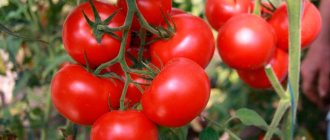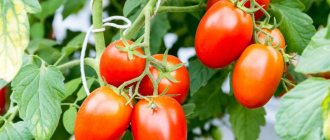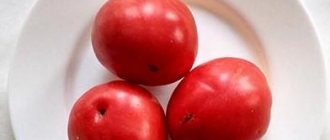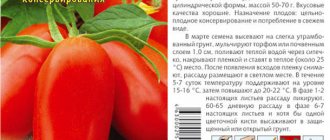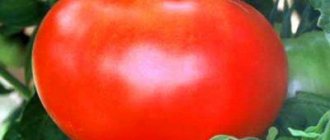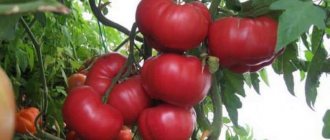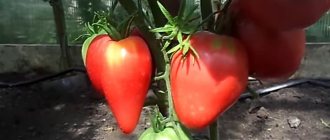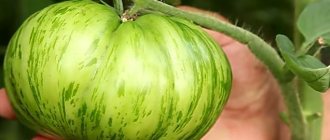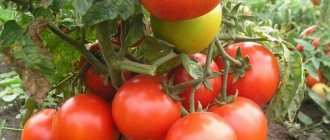» Vegetable growing » Tomatoes » Tomato variety Long Keeper
0
1121
Article rating
Tomato Long Keeper is a real find for those who want to prepare fresh tomatoes for the winter. This late variety is known for its excellent yield and long shelf life. To successfully grow a tomato, it is useful to know its characteristics, features and rules of agricultural technology.
- Advantages and disadvantages
- Landing technology
- We grow seedlings
- Transfer
- Subtleties of care
- Harvesting
- Gardeners' opinion about the variety
Tomato variety Long Keeper
Brief information about the variety
- Fruits : milky-orange color, weight - from 120 to 250 g, bush - semi-determinate, medium-sized, reaching a height of 120-160 cm.
- Productivity : high - 4-6 kg per bush.
- Resistance : good immunity to most diseases is observed, but the variety is susceptible to late blight.
- Distribution : grown both in the south (in open ground) and in the middle zone (in greenhouses and film greenhouses).
- Application : can be eaten fresh, as well as salted and canned.
- Planting : sowing - in mid-March, transplanting - in the second half of May according to the 40X50 cm pattern.
- Soil : turfy, light soil is suitable.
- Care : water once every 10 days, feed 2 times a month, formation is carried out in 1 stem, a garter is required.
- Ripening period : late-ripening variety, fruits ripen 120-135 days after germination; shelf life – 3 months or longer.
Tomato Long Keeper
Late-ripening, determinate, productive tomato variety for long-term storage. Recommended for cultivation in open ground and greenhouses.
The bush is medium-sized (up to 1.5 meters in a greenhouse), medium-sized leaves, green with a metallic sheen. The inflorescence is simple. The first inflorescence is laid above the 7th leaf, the subsequent ones - after 1-2 leaves.
Basic qualities of fruits
The fruits are flat-round, smooth, weighing 130-150 grams. The color of the unripe fruit is whitish. The fruits on the plant ripen very rarely; when ripe, they acquire a whitish-orange color. Fruit ripening occurs 30-35 days after picking. These tomatoes have a rather mediocre taste, but it is still better than the taste of the “woody” winter hybrids. They are mainly used for canning and pickling, as well as for fresh consumption during the winter months.
It is advisable to sow seeds for seedlings 65-70 days before the intended planting in the ground.
Planting pattern: 50 x 40 cm, planting density: 6-8 plants per 1 sq. m.
Advantages of the variety: stable yield, high density of fruits, long-term preservation of commercial qualities of fruits (for 60-80 days), which allows you to extend the period of consumption of fresh products.
The variety is resistant to tobacco mosaic virus, fusarium, and cladosporiosis.
The Long Keeper tomato variety is included in the State Register of the Russian Federation for cultivation in open ground, unheated film greenhouses and under temporary film shelters.
Originator of the variety: TomAgros.
If you grew Long Keeper tomatoes, please write what the yield and taste of the fruits of this variety were in your conditions? How tall were the bushes? How long did the fruits last without losing their taste and good appearance? Briefly describe the advantages and disadvantages of this tomato in your opinion. If possible, attach a photo of these tomatoes to your comment. Thank you!
Your reviews of the Long Keeper tomato and additions to the description will help many gardeners evaluate this variety more objectively and decide whether it is worth planting or not.
Description of the variety
Long Keeper tomatoes are semi-determinate type. The medium-sized bush reaches 120-160 cm, but in a greenhouse it can grow up to 200 cm. The fruit ripening period is late, the harvest is harvested 120-135 days after germination. Tomatoes are tied in clusters of 4-6 pieces.
Fruit
Tomatoes have a round, slightly flattened shape.
The fruits have a very unusual coloring, which makes the variety special among other varieties.
As they grow, they acquire a milky hue, and at the stage of full ripeness they become pale orange or pinkish-yellow. At the same time, they are bright red inside.
Fruit weight is from 120 to 250 g. The pulp and skin are dense. Taste – tomato (sweet, sour).
The harvest is harvested fresh for the winter - used for salads, slices, and main courses. In addition, they can be canned or salted. The excess is processed into sauces or pastes.
Productivity
The variety gives consistently high yields. 4-6 kg of fruits are collected from one bush. To increase productivity, it is recommended to grow tomatoes in a greenhouse and form the bushes into one stem.
Tomato Long Keeper
A variety of Soviet selection, high-yielding, late-ripening.
In the middle zone it is recommended for cultivation in greenhouses; in the southern regions it can be cultivated in open ground.
The plant is powerful, medium-sized (up to 1.4 m), determinate type, requires tying to a trellis, pinching is not necessary. It is recommended to form this tomato into one or two stems.
The variety is unpretentious in cultivation, resistant to fusarium, tobacco mosaic, and cladosporiosis. Productivity is about 6 kg per bush. The fruits, having reached full ripeness on the bush, may begin to crumble.
The fruits ripen in clusters, flat-round in shape, medium to large in size (150-300 g), and light pearl-orange in color when fully ripe. Fruits should be collected and stored in a state of technical ripeness - whitish-green in color. The skin is smooth, dense, the flesh is very dense, red-pink in color, good sweet taste with a slightly noticeable sourness.
The fruits are easily transported and have a very long shelf life - up to February-March. Recommended for fresh consumption, canning and processing.
Advantages and disadvantages
Tomatoes are not very juicy
The advantages of the variety include:
- Long shelf life (over 3 months);
- High yield (up to 6 kg per bush);
- Resistance to most diseases;
- Excellent transportability of fruits;
- Tomatoes can be picked unripe and successfully ripened at home.
As a disadvantage, some consider the taste of the fruit, which in itself is not bad, but inferior to summer varieties. However, according to gardeners, tomatoes are still tastier than the tomatoes sold in stores in winter. Another disadvantage of the variety is its susceptibility to late blight.
Pros and cons of the Long Keeper tomato variety
Advantages of the Long Keeper hybrid:
- excellent shape and high density of tomatoes;
- long-term preservation of fruits both in terms of taste and marketability (in room conditions until January, in the cellar - until March);
- excellent transportability over long distances;
- resistance to most pests and diseases, in particular to fusarium, brown leaf spot, tobacco mosaic virus;
- consistently high yields, regardless of weather conditions;
- versatility of use.
Disadvantages of the variety:
- late ripening, as a result of which the fruits do not have time to ripen;
- When ripening on the bush, tomatoes that have reached technical ripeness often fall off;
- the taste of the fruit is a little fresh;
- Over time, the skin and seeds become coarser;
- tomatoes need constant pinching and tying up.
Landing technology
Seeds for seedlings are sown in mid-March (for open ground - 2 weeks later). In the second half of May, tomatoes are transplanted into a greenhouse. Seeds are sown in a tray with disinfected soil mixture (turf soil, peat and compost in equal parts) to a depth of 0.5-1 cm.
The sowing is watered with warm water from a spray bottle and covered with plastic wrap. Before emergence, the temperature is set at 24-25°C.
We grow seedlings
When the sprouts hatch, the film must be removed from the tray and the temperature reduced to 16°C (after a week it is raised again to 22-24°C). The seedlings are placed on the windowsill; water every 10 days with warm water.
When 2-3 true leaves appear, the plants are planted in separate pots.
():
The volume of cells of cassettes or individual cups for picked seedlings must be at least 250 ml.
2 weeks before transplanting, the tomatoes are hardened - taken outside every day for several hours (the hardening time is gradually increased to a whole daylight hours).
Transfer
Compost is added to the soil in the garden bed, watered with a manganese solution and loosened. Install high stakes or a trellis for gartering the bushes. The distance between holes is 40 cm, between rows is 50 cm.
A handful of ash, humus and crushed eggshells are placed in each hole; Pour in plenty of warm water. Plants are placed in holes, covered with soil, hilled and mulched.
Diseases and pests
"Long Keeper" is highly resistant to diseases:
- Tobacco mosaic;
- Fusarium;
- Cladosporiosis.
If the beds are poorly ventilated and crop rotation is disrupted, the plants suffer from late blight. Effective folk remedies against this disease are treating the affected bushes with an infusion of garlic, a decoction of onion peels and dusting with ash. As a last resort, resort to the help of insecticides “Barrier” or “Barrier”.
Of the pests that cause the greatest damage to plantings:
- Thrips. Several sticky traps placed in the greenhouse will help get rid of insects;
- Aphid. Affected plants are sprayed with a soap solution;
- Spider mite. The most effective anti-tick medications are Fitoverm and Karbifos.
Subtleties of care
7-10 days after transplantation, the seedlings are tied to a support. The bushes are formed into 1 stem, the lower leaves are gradually removed. Water every 10 days strictly at the root (as they grow, use 2 to 5 liters of warm water). Fertilizing is done once every 2-3 weeks, alternating organic fertilizers with mineral ones.
For the first time, tomatoes are fertilized with ammonium nitrate or other nitrogen fertilizers. Next, use complex mineral fertilizers containing nitrogen, phosphorus and potassium, as well as herbal infusions, solutions of mullein (in a ratio of 1:10) or bird droppings (in a ratio of 1:20).
():
The third feeding during the period of fruit formation and growth is carried out with phosphorus-potassium fertilizers.
After watering, the soil in the garden bed is loosened or mulched, and weeded as necessary. To prevent late blight, the greenhouse is often ventilated, and the plants are sprayed with Bordeaux mixture.
():
Other copper-containing preparations can be used to prevent and combat fungal diseases: copper oxychloride, copper sulfate, Abiga-Pik.
Growing
Gardeners grow Long Keeper tomatoes mainly in seedlings. Important agrotechnical measures are:
- watering;
- feeding;
- loosening;
- mulching;
- formation;
- garter;
- stepsoning.
Growing seedlings
It is recommended to sow seeds to obtain seedlings in the first or second decade of March. Recommended soil mixture composition:
- garden soil - 2 parts;
- sand – 1 part;
- humus - 2 parts.
Seeds should be pre-disinfected in a manganese solution. Then it is recommended to soak them in growth stimulants or in a solution of sodium humate.
The distance between seeds should be on average 3 mm. The crops are sprinkled with a layer of peat on top. The optimal temperature for seed germination is at least 25 °C. It is recommended to reduce the temperature immediately after emergence, maintaining it at 20-22 ° C during the day and several degrees lower at night.
Comment! Seedlings are picked when several true leaves appear. For this purpose, planting pots of at least 10 cm in diameter are used.
Landing rules
The seedlings are transplanted into the greenhouse when they reach the age of 1.5-2 months. Seedlings are planted in garden beds when the threat of night frosts has finally passed, when the soil has warmed to 14-15 °C. The approximate date for planting seedlings is the end of May.
Advice! A week before the planned planting, it is recommended to feed the seedlings with potassium-phosphorus fertilizers. To stimulate survival, the roots of seedlings can be soaked in a rooting solution before planting.
You can get high yields by correctly placing plants in the beds. The maximum permissible number of seedlings per 1 m2 is no more than 8 plants.
Recommended planting pattern:
- the gap between bushes is at least 40 cm;
- row spacing of at least 50 cm;
- planting depth – 12-15 cm.
Watering and fertilizing
Important measures for caring for Long Keeper tomatoes are watering and fertilizing. Tomato bushes are fed 2-3 times during the growing season, including fruit formation. For this purpose, complex mineral fertilizers or organic matter (mullein, chicken droppings) are used.
Long Keeper tomatoes should be watered regularly, every 2-3 days. Drip irrigation is considered the most preferable.
Watering rules:
- The water should be warm and settled.
- Watering should be done in the morning or after sunset.
- It is necessary to prevent water from getting directly onto the foliage.
Pinching and tying
Long Keeper tomato bushes definitely require tying to trellises. Tie the plants to support pegs 2 weeks after planting. It is also necessary to regularly remove stepchildren. The procedure should be carried out at the earliest possible stages.
Formation
To obtain maximum yield, Long Keeper bushes should be shaped. In case of thick planting (placement of 4 seedlings per 1 m2), the formation is carried out in 2 stems, in case of dense planting (6 bushes per 1 m2) in 1 stem.
Protection from diseases and pests
Tomato Long Keeper is immune to the following viral diseases:
- cladosporiosis;
- fusarium;
- tobacco mosaic.
Violation of the ventilation regime can lead to late blight. Treatment can be carried out with the help of special chemicals or using folk remedies.
Attention! To prevent fruits from being affected by fungal diseases, their contact with the ground should be avoided.
Harvesting
According to the description, late tomatoes do not always have time to ripen before the onset of frost. The fruits can be collected at the stage of incomplete ripeness and then ripened at home.
Typically, Long Keeper tomatoes are picked while still in the milky ripeness phase (they gradually turn pink during storage).
If the fruits of this variety have already ripened on the bush, you should not delay the harvest, otherwise the tomatoes may fall off. The fruits are stored in a cool but dry place, separate from other tomatoes. The keeping quality of this variety is beyond praise (up to 3 months or longer).
Tomato red stone. 10 varieties of tomatoes that last until next year
To store tomatoes for the winter, breeders have developed special varieties that have small seed chambers, thick walls and dense pulp. Breeders managed to reduce the synthesis of ethylene in them, which determines the ripening period of tomatoes. These varieties can be saved until next year; they are divided into several groups.
Group 1 - varieties are stored until the New Year.
1. Lightweight.
High-yielding variety with red fruits. Disease resistant.
2. Rozhdestvensky.
Stored until early January. When ripe, the fruits turn orange-red. Meaty and tasty tomatoes.
3. Winter cherry.
Small-fruited variety, bright orange tomatoes, the bush bears fruit in large clusters.
4. Vladimir-3.
Late-ripening and productive variety. Dense red fruits.
Group 2 - varieties are stored until spring.
1. Gift of autumn.
The fruits are large, up to two hundred grams. Late variety. At first the fruits are greenish-yellow, then orange. The inside of the fruit is red. Juicy and tasty. Wall thickness up to 7 mm.
2. Red stone.
If translated from English, it sounds like “Red Stone”. Mid-season, productive variety. The fruits are dense and heavy. Wall thickness - up to 9 mm. They are planted later than regular varieties so that they last until spring.
3. Russian sensation.
Large fruits up to 200 grams. Tomatoes are orange at first and then ripen and change color to red.
4. Masterpiece-1 and Masterpiece-2. Late varieties with milky red fruits. One of the most common varieties for long-term storage.
Gardeners' opinion about the variety
According to gardeners, the Long Keeper variety fully corresponds to the description: the main advantage of tomatoes is their long shelf life - many vegetable growers keep them until the end of February, and some until mid-March.
Most agree that the fruits are not as juicy and tasty as summer varieties, but for long-term storage they are the best alternative.
Gardeners advise keeping the bushes in one stem and tying them to high stakes - in addition to good yield, this ensures ease of care. Among the diseases affecting this variety, vegetable growers note only late blight. Tomato is resistant to other diseases.
Description of the main varietal characteristics
Most summer residents strive to get an early tomato harvest, so varieties and hybrids of medium, mid-early, early ripening are in great demand. Description Long keeper is distinguished by timing; it is a late ripening variety (130-135 days).
The main varietal feature of Long Keeper can be considered that the fruits never ripen directly on the bush. This applies not only to plants grown in open ground. Tomatoes growing in a greenhouse are also picked green. More precisely, their color at the time of removal is white-green, pale.
